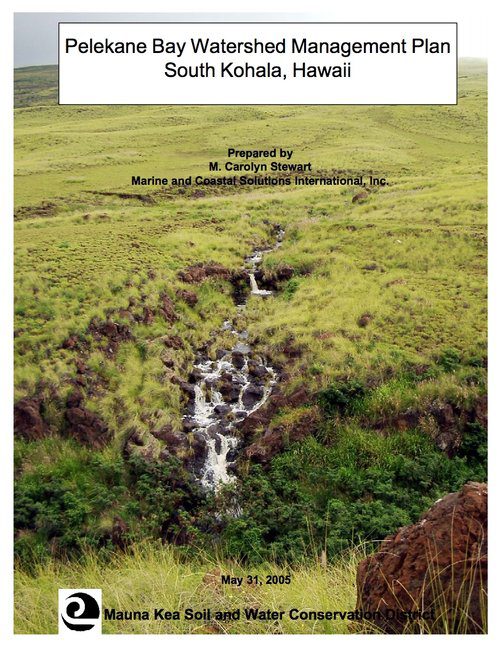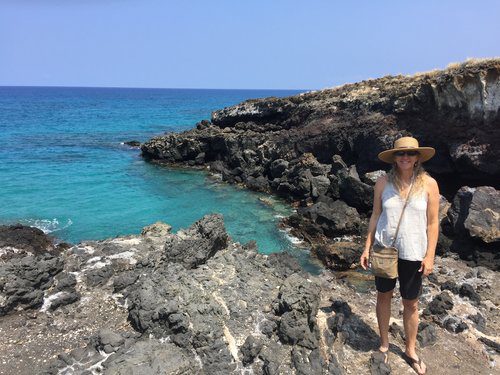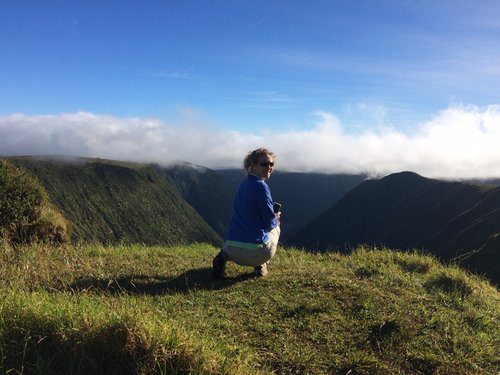In "Partner Perspectives" we get to know the diverse people, roles, and views of wildfire management in the Pacific. Carolyn Stewart kindly spent some time with us discussing her experiences working in natural resource and watershed management in Hawaii.
Name: Carolyn Stewart
Role: Hawaii Wildfire Management Organization Board Member
Pacific Fire Exchange (PFX): Please describe what you do.
Carolyn (CS): I currently serve on the non-profit boards for the Malama Kai Foundation, Hawaii Wildfire Management Organization, and Parker School. For my paid work I am the Director of Communications for College Goals, which helps folks navigate the college applications process.
I have a graduate degree in Coastal and Marine Resources management, so when I first moved to Hawaii in 1990, after a bit of consulting work, I got a job with the State Hawaii Coastal Zone Management Program.
After seven years working for the State, my husband and I started an environmental consulting company - Marine and Coastal Solutions International. I started developing a number of watershed management plans - for Kohala Watershed Partnership, the Mauna Kea Watershed Alliance, Pelekane watershed, and Wai’ula’ula watershed. In developing and implementing the Pelekane project I got involved with the precursor of Hawaii Wildfire Management Organization. I saw wildfire in the Pelekane watershed as a potentially significant threat to watershed health.
About five years ago I got frustrated with doing environmental work in the state of Hawaii. There are many really good ideas, good things that have been done elsewhere in the world and which I think could be easily adapted to Hawaii. But it can be hard to bring new ideas into the state, so I needed to take a little break from it all. I still keep involved with environmental work through my nonprofits and I’m always willing to give advice to watershed work, which is still near and dear to my heart.
I’m always willing to give advice to watershed work, which is still near and dear to my heart.


PFX: What sparked your interest in wildfire?
CS: My concern with wildfire is the effect it has on the landscape and watersheds. It takes a while for anything to grow back in dry areas that experience a fire. If there happens to be a big storm during that time, there’s a lot of potential for erosion and sedimentation in the nearshore waters.
Once I got interested in fire I started learning a bunch of new things I hadn’t really thought about - like how different grasses carry fire. Now my concerns include not just the erosion effects of fire but also damage to native ecosystems.
I’m really interested in how we can do restoration on a large scale. Questions around restoration are tricky, though. For example, restoration in West Hawaii’s dry landscape is challenging because there’s so little water. It also involves conversations about what we are trying to restore to. If, before it was burned, a landscape was grazed grasslands, should you restore it to grazing? Should you take the opportunity of a “blank slate” to try to restore it to native plants? This raises other, more socio-economic factors. I find that part of it - the people and decision-making parts - really interesting.
PFX: Can you describe a Decision-Making Process you’ve been part of?
CS: When I do a watershed plan, one of my priorities always is to engage all the users of the watershed. I really want to listen to their concerns, interests, and priorities. When I was doing work on the State’s coastal non-point pollution control program I developed a watershed plan that looked at statewide policies and county rules and regulations. It involved lots of interest groups and I really wanted to engage the plan’s users in the process. I didn’t want it to be one of these exercises where government goes in, makes decisions, comes up with a plan, and then imposes it on the people who actually have to implement the plan. I wanted buy-in early on.
To get buy-in, I had different focus groups - one each for agriculture, forestry, urban. Over several years of developing the plan we met regularly. At first people kind of thought that it was government giving lip service to public input. But, over time, I think people understood that I really wanted to hear what they had to say, that the land users were really the experts on the ground. They knew so much more than I did about certain issues. It benefitted all of us to include that knowledge and understanding in what we were doing.
After we drafted the watershed plan we had to take it out for public meetings. We were equally criticized by the environmental community and the business community, so I figured we did a good job and hit the right balance. You have to have thick skin, in some ways. I remember in those meetings, I was almost hurt by the criticisms. I had to think, “Well, let’s look at the bigger picture - we’ve done something balanced.” I felt proud of the effort
“I really believe in engaging the users of an area and trying to be more bottom-up in the approach and really listening to the people closest to the ground.”


PFX: Favorite free time activity?
CS: A lot of my free time is spent playing tennis. I’m usually on a competitive tennis team at every point in the year. I also like working in my garden. I like traveling, hiking, camping. I love hanging out with my kids, except they’re off in college so I don’t get to see them that much.
I really like to explore culture through food and I like to cook and have food-centered or musical gatherings with friends. We’ll try to cook foods we’ve never tried from a different part of the world. My comfort food is Middle Eastern food, because I grew up in Beirut. My family lived there from when I was three years old to 12 years old. In 1975 we fled Beirut nine months into the Lebanese civil war, on very short notice. That was an important part of my growing up.
PFX: What don’t most people know about you?
CS: I grew up trilingual - speaking French, Arabic, and English. English was my weakest language growing up. I’m still fluent in French - that was one language that was always easy to maintain. It was a lot harder over the years to keep up with Arabic. When my family moved back to the states from Beirut there were no Arabic speakers in the vicinity. I’m always surprised how much Arabic I understand when I hear it.
